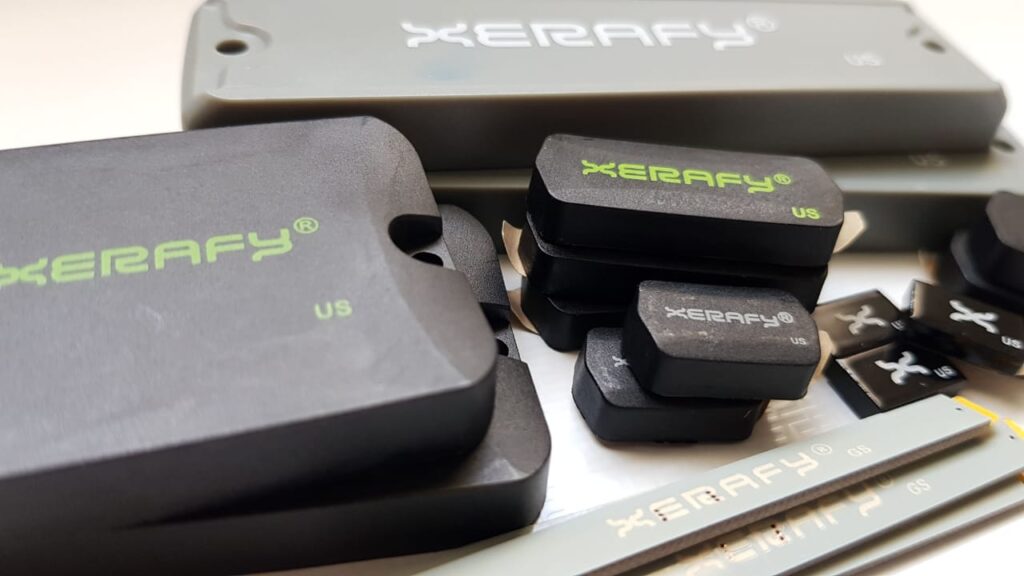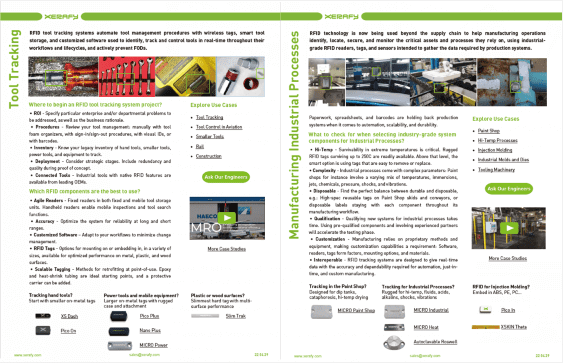RFID Frequencies 101
The Xerafy engineering team’s guide to RFID Frequencies for accurate asset tracking and inventory management
UHF is the RFID frequency of choice for tags and readers used in asset tracking and inventory management. Other RFID frequencies are also available for specialized applications. This guide prepared by the award-winning Xerafy engineering team breaks down when to use UHF, HF and LF frequencies.
Passive UHF RFID has evolved into the de facto standard for industrial asset tracking. In doing so, it has relegated HF and LF RFID to niche applications such as fixed assets and very close ranges.
The ISO/IEC 18000-63 standard ensures interoperability between UHF RFID readers & tags. It is designed to regulate the use of passive-backscatter radio frequency identification (RFID) systems.
These systems are made up of interrogators (also known as readers), which send information to tags and labels in modulated radio waves. The tags receive the information and operating energy from these waves, which power passive tags entirely.
Ordinarily, an interrogator sends out a continuous-wave (CW) RF signal prompting the tag to modulate its antenna reflection coefficient to backscatter an information signal. This communication process is called Interrogator-Talks-First, meaning a tag will only send its response after being directed by an interrogator. In addition, communications are half-duplex: interrogators talk while tags listen or vice versa.
Overview of RFID Frequencies
| UHF Ultra High Frequency | HF High Frequency | LF Low Frequency |
|
|---|---|---|---|
| Frequency Range | 300 MHz to 3 GHz | 3 to 30 MHz | 30 kHz to 300 kHz |
| RFID Systems Operating Bands | 900-915 MHz (regional variances) | 13.56 MHz | 125 kHz or 134 kHz |
| Read Ranges | Up to 25 meters | 10cm to 1 meter | 10cm |
| Data Transfer Speed | 20x faster | Slow | Slow |
| Tag Unit Cost | $-$$ | $$-$$$ | $$ |
| Use Cases and Standards | Item-Level Tracking, Asset Management Inventory Control, Supply Chain RAIN RFID Alliance / EPC Global Gen2 (ISO 18000-63) | NFC Payments (ECMA-340 and ISO/IEC18092) MIFARE Ticketing (ISO/IEC 14443 A and ISO/IEC 14443) FeliCa payments (JIS X 6319-4) Traceability (ISO 15693) | Livestock (ISO14223, ISO/IEC18000-2) Microchips (ISO 11784/85) Access control |
UHF RFID Tags - Best for Asset Tracking, Inventory Control, Supply Chain
Ultra High Frequency RFID (300 MHz to 3 GHz range) has become the preferred identification technology for manufacturing asset tracking, warehouse inventory control, and logistics management.

Today, numerous companies and organizations including Wal-Mart, Target, the US Department of Defense, mandate their suppliers provide every product and pallet with RFID tags.
+ UHF tags typically operate at 860 to 960 MHz for RAIN RFID systems, in compliance with the UHF Gen2 standard.
+ Tags offer long read ranges of up to 30 meters (passive/without battery) and offer fast data transfer.
+ While standard UHF is affected by liquid and metallic environments, optimized tags work well around them such as on-metal tags.
Technically, UHF is ideally suited for assets in motion and uncontrolled positions because it allows for fast data processing (imagine an asset moving quickly on a conveyor belt), increased accuracy (identifying items in bulk in seconds), and extended read ranges (over several meters).
UHF RFID has evolved significantly over time to operate effectively around metals and liquids that would normally be difficult to penetrate due to the materials’ ability to reflect and change the tune of radio frequencies.
HF RFID Tags - Best for Payments and Tickets
High-Frequency RFID (3-30 MHz range) has found its niche with payments (aka NFC), smart products for consumers, and ticketing:
+ HF RFID typically operates at 13.56 MHz.
+ HF tags have a limited read range of up to 1 meter.
+ Data transfer speed is slow, while faster than LF.
+ HF RFID is affected by liquid and metallic environments, but can be shielded if necessary.
LF RFID Tags - Best for Access Control and Livestock
Low Frequency RFID (30 to 300 kHz range) is appropriate for short-range and small-data applications such as animal identification (e.g. ISO 11784 and 11785 for microchips) and access control:
+ Typically operates at 125 kHz and 134 kHz.
+ LF tags have a short read range of approximately 10 cm.
+ Very slow data transfer.
+ LF is the RFID frequency less susceptible to interference by liquids and metals thanks to its longer wavelength.
Is NFC RFID?
Yes, Near Field Communication (NFC) is best described as a subset of RFID and is commonly available in mobile phones.
NFC devices operate at the same frequency as high-frequency RFID readers and tags — 13.56 MHz. But unlike RFID devices and tags, NFC takes advantage of the short-read range limitations of its radio frequency. This allows for data to be transmitted securely and quickly, with lower power consumption than other wireless communication technologies such as Bluetooth.
Contactless payment systems are the obvious application and include Apple Pay, Google Pay, Samsung Pay, etc. The widespread availability of NFC technology in mobile phones makes NFC tags an appealing option for Smart Products and other applications with strong consumer involvement such as product authentication.
What are the regional RFID frequencies?
The global standardization of UHF RFID is led by the RAIN Alliance, with most countries operating between 900 and 915 MHz.
The RAIN RFID standards are based on the UHF RFID protocol known as EPC Gen2v2, which includes features such as multi-protocol support and enhanced security. They are classified based on region/country as follows:
The USA
Europe
Japan
China
India
Australia
Singapore
US RFID Frequencies
The RFID standard for the USA is FCC Part 15.247, which defines the parameters and guidelines for UHF RFID operating in the 902-928 MHz spectrum. RFID systems compliant with these regulations are designed to maximize power output and reader range. Using frequency-hopping spread spectrum modulation, UHF readers can transmit 1 watt of power or, if used with a directional antenna, up to 4 watts across 50 different channels.
EU/EU2 RFID Frequencies
ETSI EN 300-220-1 is an important regulation for SRD radio transmitters and receivers. It specifically defines the technical characteristics of these devices to avoid any interference with other communication systems such as aircraft navigation.
This standard applies to 25 to 1000 MHz radio equipment with power levels of up to 500 mW & 0.25 MHz bandwidth. Furthermore, the frequency range for these devices is 869.4 to 869.65 MHz, with a maximum allowed power of 0.5 watts ERP, one channel, and a 10 percent duty cycle.
EU has approved the creation of a new Upper Band (915 – 921 MHz) for RFID use. This higher frequency range, with a channel bandwidth of 400 kHz (similar to current US Band), could bring various advantages to RFID users. For example, read range and coverage could increase by up to 40-50% compared to the lower band, while read rates could be faster due to the increased channel bandwidth.
Additionally, users will find more compatible product options with FCC tags and antennas throughout Europe. Deployment is also quicker and more cost-effective since companies can use the same products across different countries.
RFID Frequencies in Japan
The MID has set forth certain regulations and standards that must be met to use the UHF spectrum range of 952–954 MHz for RFID. Moreover, high-powered passive tag systems are limited to an antenna power between 10 mW to 1 W and an antenna gain of 6 dBi, which gives a maximum power equivalent to 4 W EIRP. These regulations help ensure RFID systems are safe and secure while allowing them to operate at optimal levels.
RFID Frequencies in China
The Chinese government has been developing its own RFID standards to keep up with global standards. These standards are developed & implemented by the Standardization Administration of China (SAC). The body oversees numerous Technical Committees specializing in different areas of technology and business.
One of these committees is the RFID National Standards Working Group. This organization is responsible for standardizing hardware-related RFID issues such as frequency allocation, bandwidths, tag-to-reader compatibility, data management protocols, and privacy considerations.
The Article Numbering Center of China (ANCC) is the primary organization responsible for encoding goods with RFID tags in China. It works with the SAC to ensure that products encoded in China are compliant with international standards, such as the Electronic Product Code (EPC).
RFID Frequencies for India
The Ministry of Communications and Information Technology’s Department of Telecommunication (DOT) is responsible for RFID regulations. It has set forth several regulations to ensure the smooth functioning of 865-867 MHz band RFID devices.
For example, all users must operate at a maximum transmitter power of 1 W and an effective radiated power (ERP) of 4 W, with carrier bandwidth limited to 200 KHz. Furthermore, all RFID operations must be conducted on a noninterference, nonprotection, and nonexclusive basis.
RFID Frequencies in Australia
The Australian Communication Authority has been actively considering the international industry-driven standards for Electronic Product Code (EPC)-class RFID systems. To meet the global standards for EPC, the Authority has set the UHF band for RFID operations in Australia at 918–926 MHz with a power of 1 W EIRP. This frequency is also suitable for supply chain and asset tracking applications.
RFID Frequencies for Singapore
The Infocomm Development Authority (IDA) of Singapore has introduced a new spectrum allocation & power limit for UHF RFID usage. All RFID activities are permitted to operate within the 866–869 MHz and 923–925 MHz bands, with both having an allocated power limit of 0.5 W (with the possibility of increasing the power to 2 W for 923-925 MHz bands in the future).
